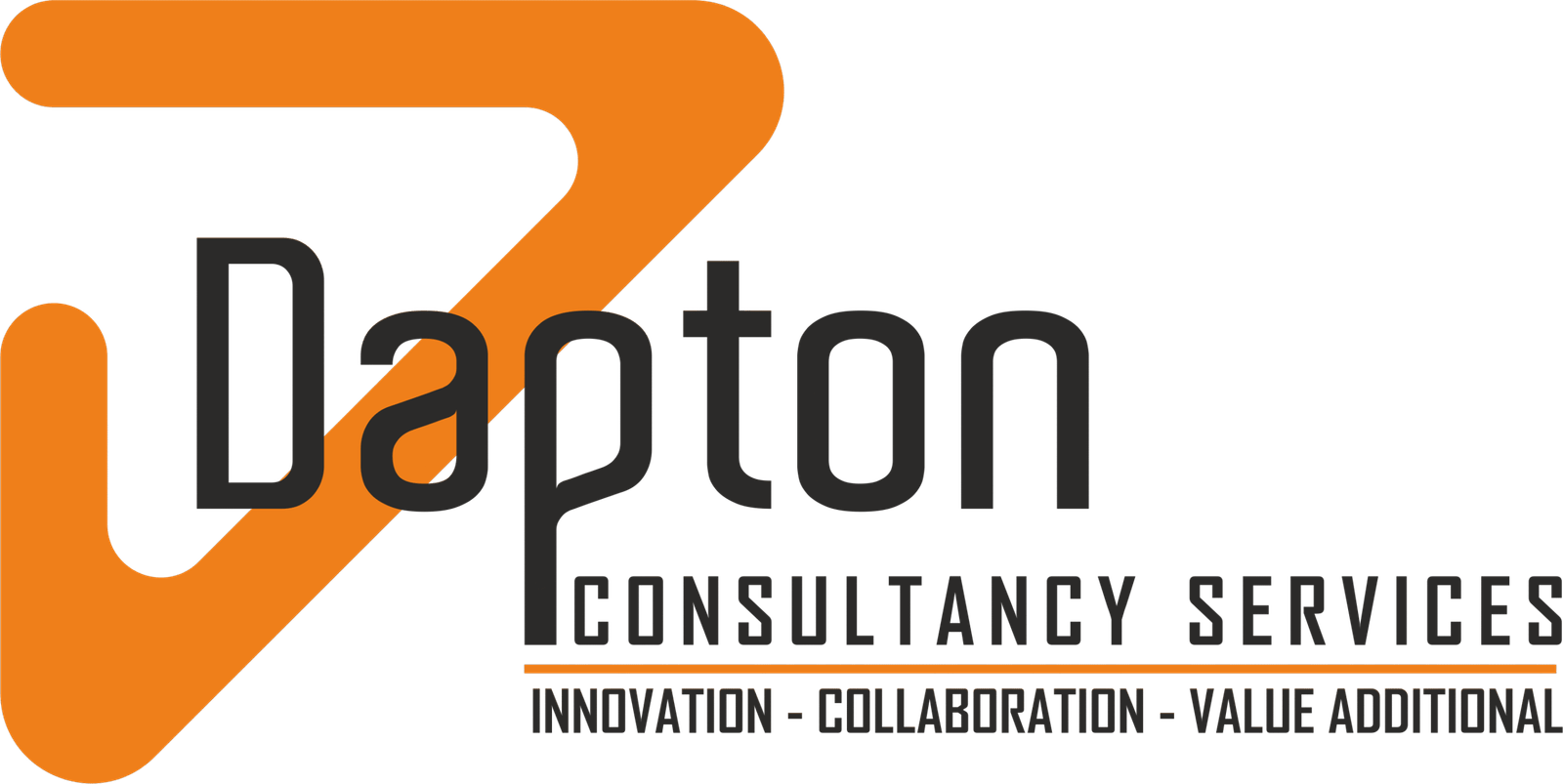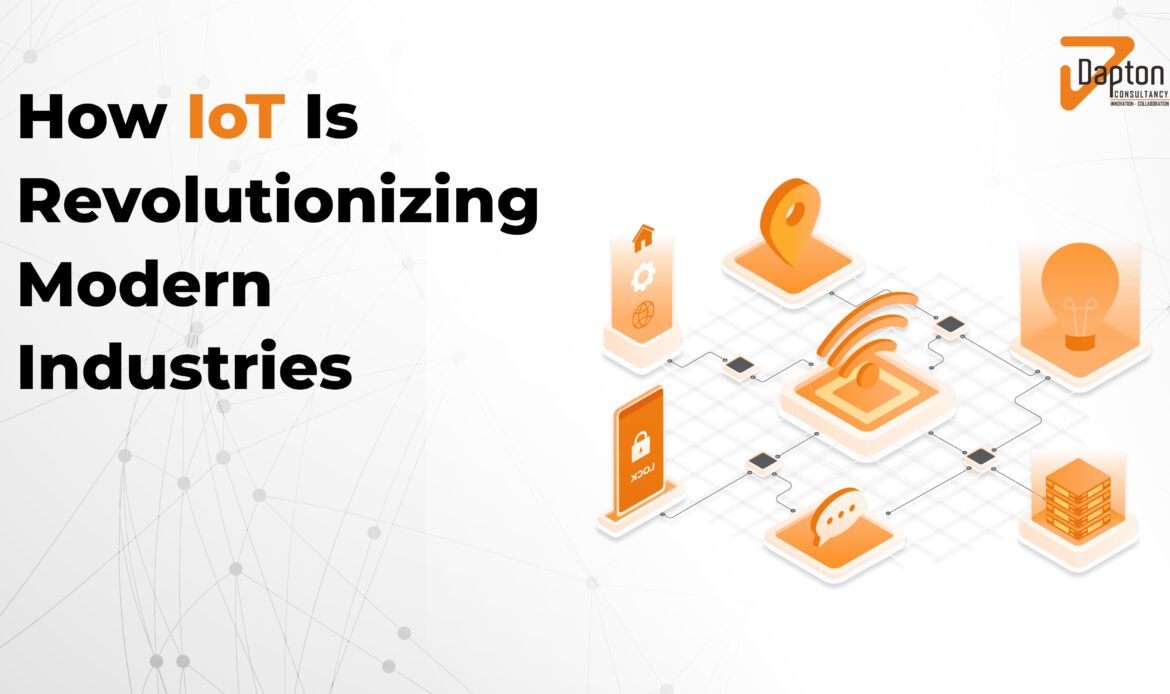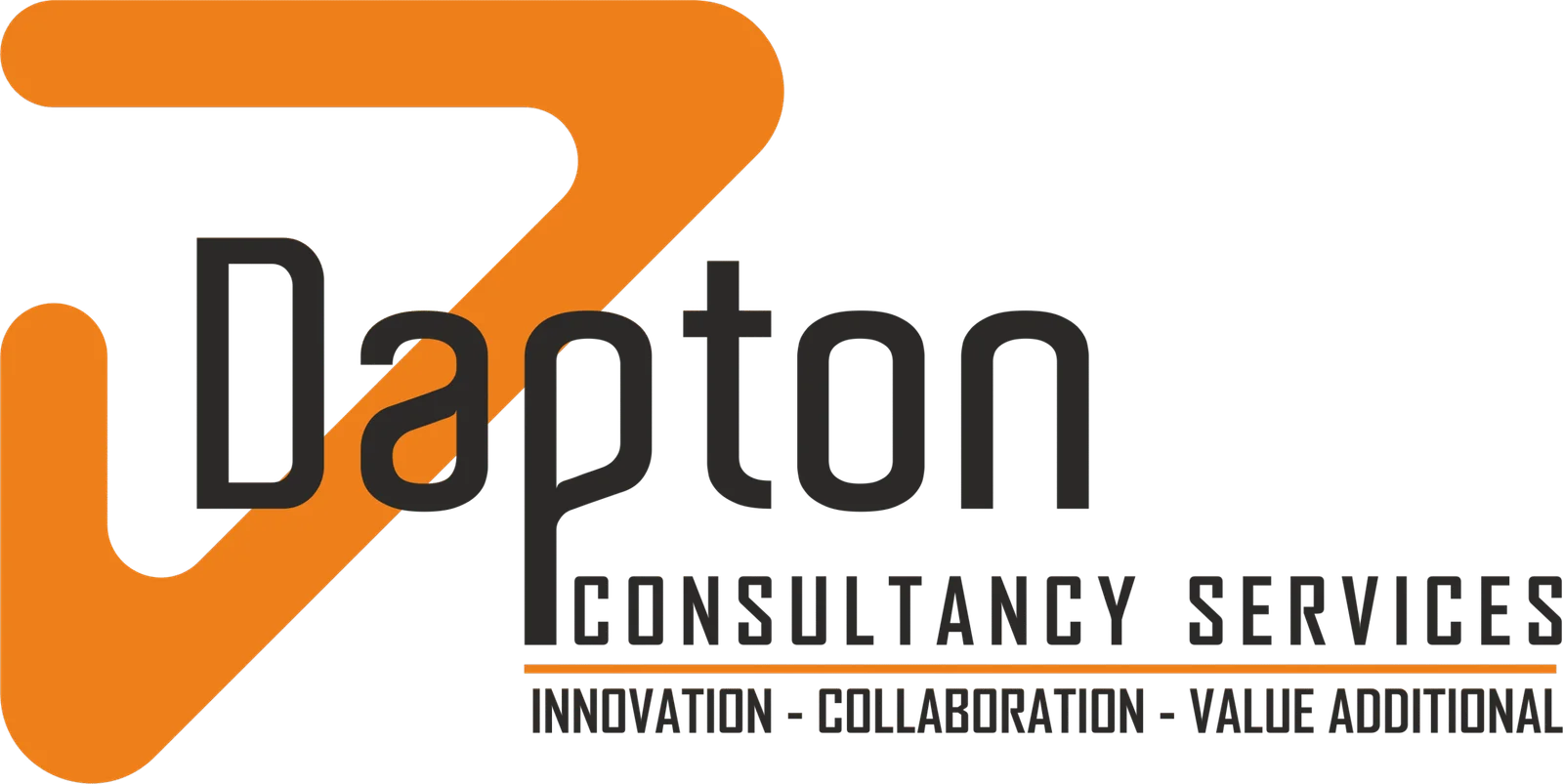The Internet of Things (IoT) has become a cornerstone of industrial transformation across the globe. It refers to a – vast network of diverse interconnected devices. These IoT devices are precisely embedded with – sensors, software, and connectivity. They collect and exchange data to drive smart decisions.The global count of IoT devices is projected to surge from – 19.8 billion in 2025 to over 40.6 billion by 2034. This will mark a dramatic expansion in – digital connectivity and intelligent infrastructure across industries.Furthermore, IoT and data-driven disruption are reshaping the way industry functions. Businesses are already rethinking everything starting from modern technology solutions, resource allocation, and sustainability.The answer to how IoT is transforming industries lies in its ability to – make machines talk, environments react, and insights flow. Let us further explore how IoT in modern industries is setting the stage for – intelligent, leaner, and responsive operations.How IoT Really Works
IoT connects the physical world to digital intelligence – whether it is – smart valves monitoring oil pipelines or wearables tracking human health.This seamless integration enables real-time data collection and automated responses across diverse environments. IoT solutions ensure that every decision is informed by real-time intelligence.So, at its core, IoT operates through a simple, yet powerful loop 1) Collect Data: Sensors gather data from – machines, humans, and environments2) Transmit Data: This data is transmitted to – cloud or edge platforms.3) Extract Insights: Analytics engines process the – information to fetch insights.4) Trigger Actions: Based on insights, automated actions are triggered. These actions comprise – sending alerts, adjusting machine parameters, and initiating preventive measures.
1) Collect Data: Sensors gather data from – machines, humans, and environments2) Transmit Data: This data is transmitted to – cloud or edge platforms.3) Extract Insights: Analytics engines process the – information to fetch insights.4) Trigger Actions: Based on insights, automated actions are triggered. These actions comprise – sending alerts, adjusting machine parameters, and initiating preventive measures.Significant Strategic and Tactical Benefits of IoT
As businesses increasingly embed IoT into their business operations, the advantages are both – tactical and strategic.1) Cost Reduction and Predictive Maintenance
One of the most tangible benefits of IoT is the ability to detect issues before they become expensive failures. IoT sensors continuously monitor machine health, usage patterns, and environmental conditions.Predictive algorithms can then schedule maintenance proactively. This ensures – reduced downtime, lower repair costs, and extended asset lifespan.2) Increased Operational Efficiency and Productivity Gains
By automating decision triggers, IoT helps – eliminate manual tasks, shorten response times, and ensure smoother workflows.Smart factories and warehouses use sensors to – regulate temperature, manage inventory, and track performance—all contributing to streamlined operations.3) Quality Control and Compliance
Sensors can monitor variables like humidity, temperature, and vibration during production and storage. This ensures – high product quality, compliance with industry standards, and real-time audit trails for regulators.4) Energy and Sustainability
Connected energy devices monitor and adjust consumption based on usage patterns. In sectors like manufacturing and utilities, this leads to – a reduction in energy consumption, lesser carbon footprints, and efficient grid balancing.Subsequently, IoT for energy optimization turns passive infrastructure into – intelligent and responsive ecosystems.5) Improved Decision-Making with Real-Time Data
The impact of IoT on industries is reshaping traditional operations. As adoption accelerates, IoT in modern industries will continue to – unlock transformative value across diverse industry domains.The benefits of IoT for industries include – enhanced forecasting and adaptive planning mechanisms. With every connected device feeding data into analytical systems – decision-makers gain real-time visibility.Industrial IoT Transformation & Real-World Examples of IoT in Business
As data-driven automation becomes the standard – industries are rapidly embracing scalable innovation powered by industrial IoT transformation. This shift is unlocking a spectrum of IoT use cases across industries.From heavy industries to public infrastructure – several industrial sectors are at the forefront of the IoT wave.o IoT in Manufacturing
Manufacturers use Autonomous Guided Vehicles (AGVs), Smart Robotics, and Connected Supply Chains to – automate repetitive tasks. Giants like Amazon and Boeing have integrated IoT to – improve efficiency and safety.| Application Area | IoT Contribution |
|---|
| Real-Time Monitoring | Sensors track equipment performance, environmental conditions, and workflow metrics to ensure smooth operations and early issue detection. |
| Predictive Defect Detection | AI-powered analytics use sensor data to identify quality deviations before they occur, reducing waste and improving consistency. |
| Inventory Optimization | RFID and IoT sensors enable precise tracking of materials and products, minimizing overstock, stockouts, and manual errors. |
o IoT in Healthcare
IoT is enabling – proactive care, reducing hospital admissions, and enhancing patient engagement. Smart medical devices and remote patient monitoring are revolutionizing healthcare deliverables.
| Application Area | IoT Contribution |
|---|
| Wearables | Devices like smartwatches and patches track heart rate, glucose levels, sleep cycles, and activity patterns—enabling early detection and chronic disease management. |
| Telehealth Platforms | Real-time diagnostics and remote consultations improve access to care, reduce hospital visits, and support continuous monitoring for patients at home. |
| Smart Infusion Pumps | IoT-enabled pumps deliver precise medication doses, prevent human error, and allow remote monitoring of infusion status and dosage accuracy. |
o IoT in Energy & Utilities
IoT is revolutionizing energy and utility management. It is turning passive infrastructure into intelligent and responsive systems.
| Application Area | IoT Contribution |
|---|
| Pipeline Surveillance | Sensors detect leaks, pressure drops, and flow anomalies in real time. This prevents disasters and reduces maintenance costs. |
| Smart Meters | Enable two-way communication for accurate billing, consumption tracking, and remote monitoring. |
| Grid Optimization | IoT devices help in balancing load, forecasting demand, and integrating renewables into smart grids. |
| Energy Efficiency | Real-time data helps reduce waste, automate HVAC systems, and optimize industrial energy use. |
| Water & Gas Utilities | IoT-enabled meters detect leaks, monitor pressure, and support predictive maintenance |
o IoT in Agriculture
Farmers can now forecast yield and minimize resource usage. They can respond swiftly to reduce droughts, maximize profitability, and sustainability. Precision farming can thus be empowered by soil moisture sensors, drone imaging for crop health, and automated irrigation systems.
| IoT Technology | Functionality & Impact |
|---|
| Soil Moisture Sensors | Monitor real-time moisture levels to optimize irrigation schedules and prevent overwatering. |
| Drone Imaging for Crop Health | Use multispectral and thermal cameras to assess plant vitality. They detect stress early and guide targeted interventions. |
| Automated Irrigation Systems | Adjust water delivery based on sensor and drone data. This reduces water usage by up to 30% while improving yield |
o IoT in Logistics
IoT is transforming logistics into a smarter and agile ecosystem. It assists stakeholders by embedding real-time intelligence across every stage of the supply chain.
| Area | IoT Contribution |
|---|
| Fleet Tracking | GPS and telematics sensors monitor vehicle location, speed, and route efficiency in real time. |
| Inventory Management | RFID tags and smart shelves automate stock tracking, reduce errors, and enable predictive restocking. |
| Cold Chain Monitoring | Temperature and humidity sensors ensure safe transport of perishables and pharmaceuticals. |
| Predictive Maintenance | IoT devices detect wear and tear early, reducing downtime and repair costs. |
| Last-Mile Delivery | Autonomous bots, smart lockers, and route optimization improve delivery speed and customer satisfaction. |
| Warehouse Automation | IoT-enabled robotics and drones streamline sorting, picking, and inventory audits. |
| Security & Safety | Wearables and smart surveillance systems protect staff and assets from theft. |
o IoT in Smart Cities
IoT here is not just about convenience – it is about building sustainable urban ecosystems. By embedding sensors and connectivity into everyday systems, cities can optimize resources, reduce environmental impact, and enhance quality of life. Connected infrastructure through IoT is transforming urban living.
| Application Area | IoT Contribution |
|---|
| Smart Traffic Systems | Utilize real-time data to manage congestion, reroute vehicles, and reduce commute times. |
| Intelligent Lighting | Adjust brightness based on ambient conditions, occupancy, and time of day to save energy. |
| Waste & Water Management | Monitor fill levels, detect leaks, and automate distribution for efficient resource use. |
Advanced Trends in IoT: Driving the Next Wave of Industrial Innovation
As IoT matures, it is giving rise to transformative technologies that – redefine how industries – operate, innovate, and secure digital ecosystems.
o Digital Twins and Virtual Manufacturing
Digital twins bridge physical and digital worlds. They empower smarter design, maintenance, and decision-making. Virtual replicas of machines, systems, or entire factories enable
- Simulations of performance under varying manufacturing conditions.
- Real-time troubleshooting to reduce downtime and improve diagnostics.
- Enhanced R&D abilities through predictive modeling and iterative testing.
o Edge Computing + 5G Integration
Combination of edge computing and 5G integration supports – real-time automation, autonomous systems, and high-speed data exchange. This fusion enables mission-critical environments and deliver
- Instant responses with ultra-low latency.
- Reduced cloud dependency and enabled local data processing.
- Greater privacy and control over sensitive industrial data.
o Security Concerns and Regulatory Compliance
With billions of connected IoT devices, the attack surface is expanding. Enterprises are responding with –
- Encryption protocols to safeguard data in transit and at rest.
- Granular access controls to prevent unauthorized device interactions.
- GDPR and compliance-ready architectures to meet data protection benchmarks.
How IoT Enables Diverse Technologies and Automation
Industrial automation with IoT is accelerating efficiency by embedding – real-time intelligence into machines, workflows, and control systems. This convergence is a key driver of IoT and digital transformation.Accordingly, IoT does not operate in isolation. It amplifies other technologies to create intelligent and secure ecosystems with -.
- Sensors: They gather real-time data from physical environments and enable contextual awareness.
- Edge computing: It processes this data closer to the source – reducing latency and enhancing responsiveness.
- Artificial Intelligence (AI): It interprets – patterns, predicts outcomes, and automates decisions.
- Blockchain: It secures – device interactions and ensures tamper-proof data trails across – decentralized networks.
Challenges and Substantial Solutions of IoT!
Despite its potential, IoT adoption is not without challenges like –
o Data Security and Management
Solution: End-to-end encryption, regular audits, and decentralized architectures.
o Integrations and Interoperability
Solution: API-driven integrations with standardized protocols across – devices and platforms.
o Cost of Implementation
Solution: Phased rollouts, pilot programs, and ROI modeling to justify investments.
o Balancing ROI with Strategic Goals
Solution: Aligning IoT with business KPIs and focusing on long-term value creation – not just immediate savings.
Key Actionable Strategy for IoT Implementation
We explored how IoT is changing the world. To truly benefit from IoT, businesses must follow a structured strategy –
Step 1: Pilot Projects
Begin with small, manageable deployments to test – viability and gather feedback.
Step 2: Scaling Up
Refine pilots into full-scale implementations across – departments and geographies.
Step 3: Seamless Integration
Connect IoT solutions with – legacy systems, ERP platforms, and business intelligence tools.
Substantial Queries to Ask Before Committing to an IoT Solution
Before signing your IoT partner – be sure to evaluate:
Would the solution support scalability?
Ensure it can grow with your operations and adapt to – increased device loads and geographical expansion.
What data security protocols would be in place?
Verify encryption standards, access controls, and compliance certifications like – GDPR or ISO 27001.
Can it blend with your current technology stack?
Check for API availability, platform compatibility, and ease of integration with ERP, CRM, or analytics tools.
What is the post-implementation support structure?
Assess onboarding assistance, maintenance SLAs, and access to ongoing technical or strategic guidance.
Key Takeaways
The future of IoT in various sectors seems extremely bright. As 5G matures and AI deepens its roots, IoT will unlock possibilities never imagined – from autonomous cities to self-healing supply chains.From elevating service quality to reinventing entire industries –
IoT Solutions from Dapton Consultancy Services have positioned themselves as a strategic enabler of change. IoT is not just technology – it is a business philosophy centred around intelligence, connectivity, and actionability.
 1) Collect Data: Sensors gather data from – machines, humans, and environments2) Transmit Data: This data is transmitted to – cloud or edge platforms.3) Extract Insights: Analytics engines process the – information to fetch insights.4) Trigger Actions: Based on insights, automated actions are triggered. These actions comprise – sending alerts, adjusting machine parameters, and initiating preventive measures.
1) Collect Data: Sensors gather data from – machines, humans, and environments2) Transmit Data: This data is transmitted to – cloud or edge platforms.3) Extract Insights: Analytics engines process the – information to fetch insights.4) Trigger Actions: Based on insights, automated actions are triggered. These actions comprise – sending alerts, adjusting machine parameters, and initiating preventive measures.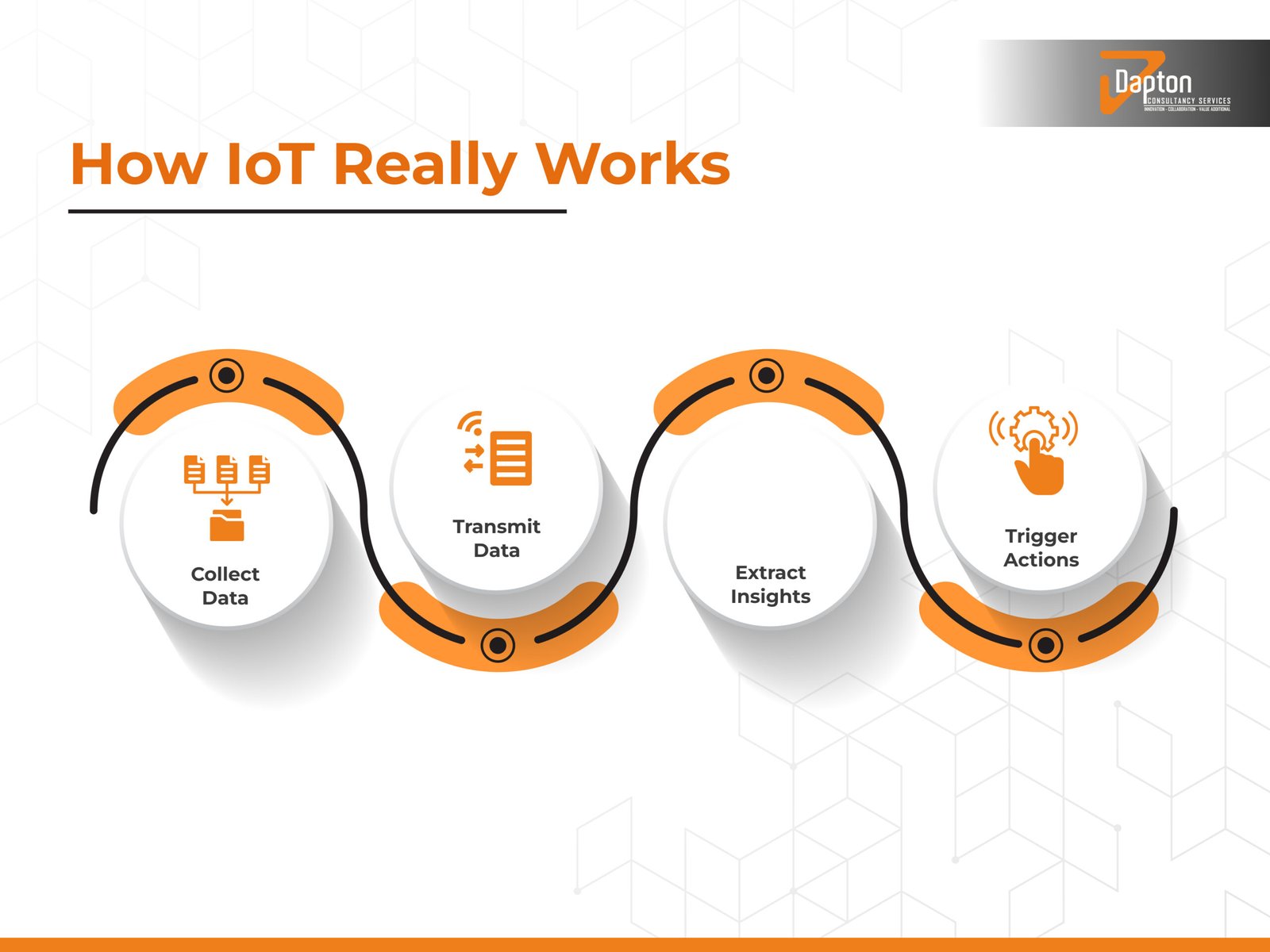 1) Collect Data: Sensors gather data from – machines, humans, and environments2) Transmit Data: This data is transmitted to – cloud or edge platforms.3) Extract Insights: Analytics engines process the – information to fetch insights.4) Trigger Actions: Based on insights, automated actions are triggered. These actions comprise – sending alerts, adjusting machine parameters, and initiating preventive measures.
1) Collect Data: Sensors gather data from – machines, humans, and environments2) Transmit Data: This data is transmitted to – cloud or edge platforms.3) Extract Insights: Analytics engines process the – information to fetch insights.4) Trigger Actions: Based on insights, automated actions are triggered. These actions comprise – sending alerts, adjusting machine parameters, and initiating preventive measures.